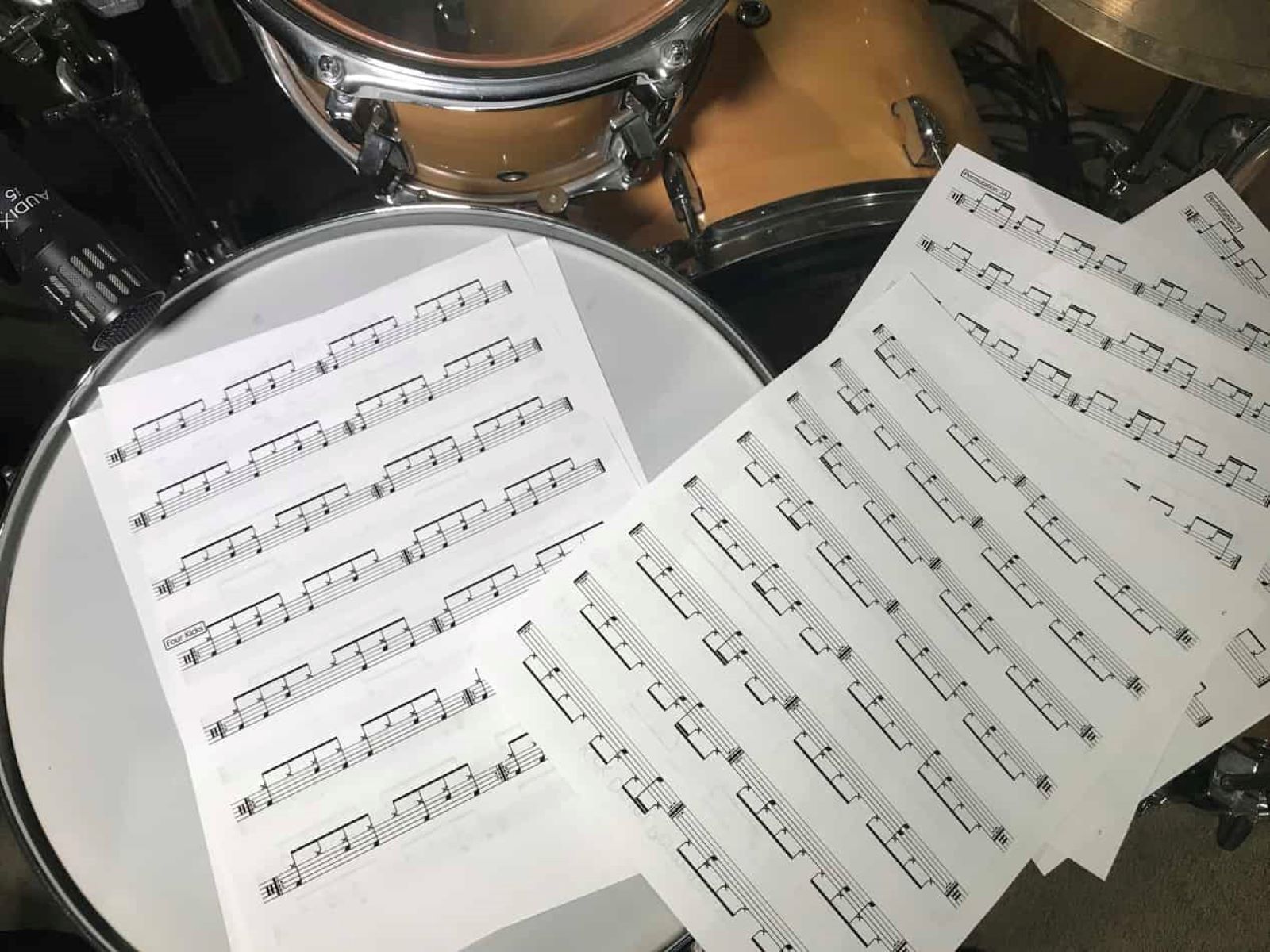

Folk
How To Write Folk Songs
Modified: March 7, 2024
Learn how to write captivating folk songs with our comprehensive guide. Master the art of storytelling, melody, and rhythm to create beautiful folk music.
(Many of the links in this article redirect to a specific reviewed product. Your purchase of these products through affiliate links helps to generate commission for AudioLover.com, at no extra cost. Learn more)
Table of Contents
Introduction
Welcome to the fascinating world of folk music! Folk music is deeply rooted in cultures around the world, reflecting the stories, traditions, and values of a community. Writing folk songs allows you to tap into this rich and diverse musical heritage, crafting melodies and lyrics that resonate with listeners on a deeper level. In this article, we will explore the art of writing compelling folk songs, from choosing a theme to adding your personal touch.
Throughout history, folk music has served as a means of expression for ordinary people, capturing the essence of their daily lives, struggles, and joys. From traditional ballads passed down through generations to contemporary folk songs inspired by today’s experiences, the genre remains an important thread in the fabric of music.
Writing a folk song gives you the opportunity to connect with listeners on a profound level, touching their emotions, and conveying messages that transcend time and place. Whether you’re an experienced musician or just starting your songwriting journey, exploring the elements of folk music will expand your creative horizons.
So, grab your instrument of choice, find a cozy spot, and let’s dive into the art of writing folk songs. The journey awaits, and the possibilities are endless. Discover the power of storytelling, the beauty of melodies, and the soulful connection that only folk music can bring. Let’s jump in!
Choosing a Theme
When it comes to writing a folk song, choosing the right theme is crucial. Folk music often revolves around universal topics such as love, loss, nature, social issues, and personal experiences. The theme you select will set the tone for your song and shape the emotions and messages you want to convey.
One approach to finding a theme is to draw inspiration from your own life experiences and observations. Reflect on the stories, emotions, and moments that have impacted you deeply. Consider the people and places that have shaped your worldview. These personal connections can serve as a powerful source of inspiration for your song.
Alternatively, you can explore themes that have a broader resonance, capturing the shared experiences of humanity. Look for topics that people can relate to and that provoke thought and emotions. Themes like overcoming adversity, the beauty of nature, or the struggles of everyday life can resonate with a wide range of listeners.
Another way to find a theme is by immersing yourself in folk traditions and cultural history. Explore the folklore, myths, and legends of your own heritage or delve into the traditions of other cultures. This can provide a rich tapestry of themes and stories to draw from.
Remember, the theme you choose should resonate with you personally, as it will be the driving force behind your creativity. It should be something you feel passionate about and can delve into deeply. The more connected you are to the theme, the more authentic and compelling your song will be.
Once you’ve chosen a theme, consider the specific angle or perspective you want to explore. Are you looking to tell a personal story or convey a broader message? Are you celebrating a particular aspect of the theme or shedding light on its complexities?
Take your time to reflect on the theme and its nuances. Jot down ideas, emotions, and images that come to mind. This brainstorming process will help you shape the direction of your song and determine the impact you want to make.
Telling a Story
One of the defining characteristics of folk music is its ability to tell compelling stories. Whether it’s a historical event, a personal narrative, or a fictional tale, the power of storytelling lies at the heart of folk songs. As you embark on this journey of songwriting, here are some tips to help you craft a captivating story within your folk song.
Firstly, establish the characters and setting of your story. Who are the protagonists? Where does the story take place? Provide enough details to paint a vivid picture in the listener’s mind, but also leave room for their imagination to fill in the gaps.
Next, consider the narrative arc of your story. What is the conflict or tension that drives the plot? Is there a resolution or a moral lesson to be learned? Structure your song in a way that takes the listener on a journey, building up to a powerful climax or poignant resolution.
Use descriptive language and imagery to bring your story to life. Paint a vivid picture with words that evoke emotions and create strong mental images. Show, don’t tell, by using sensory details and poetic metaphors to engage the listener’s imagination.
Don’t be afraid to incorporate dialogues or monologues within your song. Dialogue can add depth to characters and create a sense of connection between the listener and the story being told. It can also help convey different perspectives and emotions.
Additionally, consider the pacing and rhythm of the storytelling within the song. Use variations in tempo and dynamics to reflect the mood of different story sections. Experiment with different musical techniques, such as pauses or crescendos, to enhance the dramatic tension or emotional impact.
Remember that folk songs often have a strong oral tradition, passed down through generations. Keeping this in mind, embrace the conversational and lyrical quality of the storytelling. Use catchy melodies and memorable refrains to ensure that your story sticks with the listener long after the song has ended.
Ultimately, the key to a successful storytelling folk song is authenticity. Stay true to your unique voice and perspective as a songwriter. Don’t shy away from vulnerability or personal insights. The more genuine and heartfelt your story, the more it will resonate with your audience.
So, let your imagination run wild and weave tales that will captivate and enchant your listeners. Whether it’s an epic historical narrative or a simple vignette from everyday life, the power of storytelling in folk music is boundless.
Melody and Chord Progressions
While storytelling is a vital aspect of folk music, the melody and chord progressions play an equally important role in creating the overall mood and feel of a song. A well-crafted melody can bring depth and emotion to your lyrics, while thoughtful chord progressions can enhance the melodic journey. Here are some tips to consider when working on the melody and chord progressions for your folk song.
When creating a melody, choose notes that complement the lyrics and evoke the desired emotions. Experiment with different melodic intervals, rhythm patterns, and phrasing to add variation and interest. A memorable melody will have a distinct character and be easily recognizable to the listener.
Traditional folk melodies often have a simple and repetitive nature, making them easy to sing and remember. However, don’t be afraid to incorporate unexpected twists or melodic nuances to keep the listener engaged. Balancing familiarity with freshness is key.
Incorporate a combination of major and minor chords to add depth and emotion to your song. Pay attention to the tonal qualities of different chords and how they interact with the melody. Experiment with chord inversions and voicings to create interesting harmonic textures.
Consider the overall mood and theme of your song when selecting chord progressions. Minor chords can convey sadness or introspection, while major chords can bring a sense of joy or optimism. Explore different harmonic progressions to find the ones that best align with the story and emotions you want to express.
Don’t be afraid to borrow from traditional folk music and incorporate common chord progressions used in the genre. But also feel free to add your own unique twists and variations to make the song truly yours. Maintain a balance between the familiar and the unexpected to keep the listener engaged.
Remember, the melody and chords should complement each other and work together harmoniously. They should enhance the lyrics and bring out the intended emotions of the song. Experiment with different combinations, and trust your instincts as a songwriter to find the perfect balance.
Finally, consider the instrumentation and arrangement that will accompany your melody and chords. Folk music often features acoustic instruments such as guitar, banjo, fiddle, or mandolin. Choose instruments that enhance the authenticity and folk aesthetic of your song.
With a solid melody and thoughtfully crafted chord progressions, your folk song will come to life and resonate with listeners. So, let your creativity flow and explore the vast possibilities that melody and chords offer in the realm of folk music.
Rhyme and Meter
Rhyme and meter are essential elements of folk songs that give them a distinct structure and lyrical flow. They contribute to the overall rhythm and musicality of the song, enhancing the listener’s experience. Here are some important considerations when it comes to incorporating rhyme and meter into your folk song.
First, let’s talk about rhyme. Rhyme refers to the similarity of sounds between words at the end of lines. It can help create a sense of cohesion and musicality within your lyrics. Common types of rhyme include perfect rhyme (where the end sounds of words are identical, such as “love” and “dove”) and slant rhyme (where the end sounds are similar but not identical, like “moon” and “soon”).
When using rhyme in a folk song, strive for a balance between predictability and surprise. While regular and consistent rhyming patterns can be pleasing to the ear, don’t hesitate to mix in unexpected or unconventional rhymes to add depth and interest to your lyrics.
Another important aspect to consider is meter, which refers to the rhythmic structure of the lyrics. Meter is often measured in terms of stressed and unstressed syllables. It creates a natural flow and cadence in the song, making it easier for the listener to follow along and join in.
Traditional folk songs often adhere to specific meter patterns, such as 4/4 or 3/4 time. However, don’t feel limited by these conventions. Experiment with different meters and rhythms to find the ones that best suit the mood and message of your song.
While maintaining a consistent meter can provide stability to your song, don’t be afraid to play around with variations. Use pauses or syncopation to create dynamic shifts and add emphasis to certain lyrics or phrases. This will make the song more captivating and engaging.
Remember that rhyme and meter should serve as a tool to enhance the storytelling and convey the emotions of your song. They should never feel forced or hinder the natural flow of the lyrics. Let your words guide the rhyme and meter, ensuring that they are true to the message you want to convey.
Incorporating rhyme and meter into your folk song requires a balance of structure and artistic expression. By mastering these elements, you can create lyrics that are both musical and meaningful, capturing the essence of the folk genre.
Instrumentation and Arrangement
The instrumentation and arrangement of a folk song play a crucial role in bringing its melodies and lyrics to life. The right combination of instruments and thoughtful arrangement can enhance the emotional impact and amplify the message you want to convey. Here are some tips to consider when it comes to the instrumentation and arrangement of your folk song.
Firstly, consider the core instruments that define the folk genre. Acoustic instruments like guitar, banjo, mandolin, fiddle, and acoustic bass are commonly associated with folk music. Incorporating these instruments can add authenticity and a rustic charm to your song.
However, don’t limit yourself to traditional folk instruments. Feel free to experiment with other acoustic or even unconventional instruments that suit the character of your song. For example, a harmonica, accordion, or even hand percussion can add unique textures and flavors.
Think about the role each instrument will play in the arrangement. Determine which instruments will take on the melody, harmony, and rhythm. Remember, the melody instrument is usually the primary focus and should be given prominence.
Consider the dynamics and arrangement of the instruments. Experiment with layering and weaving the melodies and harmonies to create an intricate and cohesive sound. Vary the textures and instrumental combinations throughout the song to add interest and keep the listener engaged.
When arranging your folk song, pay attention to the pacing and dynamics. Explore different sections and variations to create contrast and build tension. Experiment with the use of instrumental solos, breaks, and instrumental interludes to add depth and variety to the arrangement.
Keep the instrumentation and arrangement in line with the overall theme and emotions of your song. For example, if your song has a somber or introspective theme, consider using softer dynamics and more delicate instrumentation. Conversely, if your song has an upbeat and lively theme, you can incorporate more energetic rhythms and vibrant instrumentations.
Remember, simplicity can be powerful in folk music. Don’t overcrowd the arrangement with too many instruments or complex layers. Sometimes, a stripped-down arrangement with just a few instruments can create an intimate and evocative atmosphere.
Lastly, consider the space and environment in which the song will be performed. If intended for live performances, ensure that the arrangement allows for easy execution by the musicians. If recording in a studio, take advantage of production techniques to enhance the sound quality and capture the essence of the instruments.
By carefully selecting the instrumentation and crafting an arrangement that complements your folk song, you can create a captivating musical experience that resonates with your audience. So, explore the vast possibilities and let the richness of the instruments and arrangement elevate your folk song to new heights.
Adding Folk Elements
When writing a folk song, incorporating traditional folk elements can add an authentic and distinctive flavor to your music. These elements connect your song to the roots of the genre, creating a strong sense of cultural heritage and tradition. Here are some ways to add folk elements to your song:
1. Use traditional folk scales and modes: Explore scales and modes commonly used in folk music to create melodies that have an inherent folk flavor. This can include scales like the Dorian, Mixolydian, or Pentatonic scales. Experiment with these scales to evoke the unique tonal qualities associated with folk music.
2. Incorporate folk rhythms and strumming patterns: Folk music often features specific rhythmic patterns and strumming techniques that give it its characteristic groove and feel. Experiment with alternating bass notes, fingerpicking, or percussive strumming to add rhythmic complexity and authentic folk texture to your song.
3. Include traditional folk instruments: To enhance the folk elements in your song, consider incorporating traditional folk instruments such as the banjo, fiddle, mandolin, or harmonica. These instruments bring their distinct timbres and playing styles, creating an unmistakable folk sound.
4. Draw inspiration from folk traditions and genres: Folk music encompasses a wide range of styles and traditions from various cultures around the world. Explore different folk traditions and genres, such as Celtic, Appalachian, or Americana, and incorporate their unique musical elements into your own songwriting.
5. Include folk-inspired harmonies: Folk music often features simple and melodic harmonies that complement the main melody. Experiment with harmonizing your melodies using parallel thirds or fifths to create a rich and layered sound.
6. Tell stories through your lyrics: Folk songs are known for their storytelling nature. Craft lyrics that capture the essence of traditional folk narratives, drawing inspiration from history, folklore, or personal experiences. Use vivid imagery and descriptive language to weave engaging and compelling stories.
7. Embrace call and response: Incorporate elements of call and response in your songwriting, creating a back-and-forth interaction between different vocal or instrumental parts. This technique adds a communal and participatory aspect to your music, reminiscent of folk music’s origins in community gatherings and social events.
8. Maintain simplicity and authenticity: Folk music often thrives on its simplicity and rawness. Don’t overcomplicate your arrangements or lyrics. Embrace the authenticity of the genre by keeping your songwriting honest, heartfelt, and true to the spirit of folk music.
By incorporating these folk elements into your songwriting, you can create a genuine and captivating folk song that resonates with the traditions and values of the genre. Infuse your music with the essence of folk and let it transport listeners to a world steeped in cultural heritage and timeless storytelling.
Adding Personal Touch
While traditional folk elements provide a strong foundation, adding your personal touch to your folk song is crucial for making it unique and reflective of your own experiences and perspective. Infusing your song with personal elements allows you to connect deeply with your music and create a meaningful connection with your audience. Here are some ways to add your personal touch to your folk song:
1. Write from your own experiences: Draw inspiration from your personal life, emotions, and observations. Share your own stories, challenges, and triumphs through your lyrics. This authenticity will resonate with listeners and create a genuine connection.
2. Express your own voice and style: Folk music is a genre that allows for individual expression. Embrace your unique voice, both in terms of singing and songwriting. Experiment with different vocal tones, phrasing, and delivery styles that best represent your own musical identity.
3. Incorporate personal anecdotes or anecdotes from your community: Weave personal anecdotes, memories, or stories from your community into your lyrics. This adds a personal touch that can be relatable and meaningful to your audience. Celebrate the small moments that make up your life and the lives of those around you.
4. Embrace your cultural heritage: If you have a cultural background, explore the folk elements within that heritage and integrate them into your music. Uncover the traditional melodies, rhythms, or storytelling techniques that are part of your cultural identity and incorporate them into your song.
5. Experiment with your musical arrangements: Use your personal musical preferences and influences to shape the arrangement of your folk song. Combine elements from other genres or experiment with different instrumentation or production techniques to create a unique sonic palette that reflects your own musical taste.
6. Add personal reflections on social issues: Folk music has a long history of addressing social and political issues. Use your folk song as a platform to express your personal reflections on important topics that matter to you. Share your thoughts on social justice, environmental concerns, or other relevant issues that resonate with your values.
7. Embrace vulnerability and authenticity: Be open and honest in your songwriting. Embrace vulnerability by sharing your true emotions and thoughts. Allow your audience to connect with you on a deeper level through the rawness and authenticity of your lyrics and performance.
8. Trust your instincts: Ultimately, trust your instincts as a songwriter. Your intuition and creative impulses are what make your music unique. Be open to exploring new ideas and taking risks, allowing your personal touch to shine through in every aspect of your folk song.
By adding your personal touch to your folk song, you create a piece of music that reflects your identity, experiences, and values. Whether it’s through your lyrics, voice, or musical arrangements, your personal touch elevates your folk song from a mere replication of tradition to a true expression of yourself as an artist.
Recording and Sharing
Once you have crafted your folk song and added your personal touch, the next step is to capture a high-quality recording and share it with the world. Recording your folk song allows you to preserve your artistry and showcase your talent. Here are some considerations for recording and sharing your folk song:
1. Set up a suitable recording environment: Find or create a space that has good acoustics and minimal background noise. Consider using a professional recording studio or set up a home studio with quality microphones, headphones, and audio interface for optimal sound capture.
2. Choose the right recording method: Select a recording method that suits your resources and technical expertise. You can choose to record each instrument or vocal separately, or opt for a live performance-style recording with multiple microphones capturing the entire performance. Experiment and find the method that best captures the essence of your folk song.
3. Pay attention to the recording process: Take your time during the recording session to ensure a high-quality result. Record multiple takes to capture the best performance and pay attention to details such as microphone placement, instrument tuning, and vocal delivery. Don’t be afraid to seek the assistance of a professional sound engineer if needed.
4. Mix and master the recording: Once the recording is complete, the next step is to mix and master the tracks. Mixing involves balancing the levels of different instruments and vocals, adding effects, and creating a cohesive sound. Mastering focuses on optimizing the final mix for distribution and ensuring it sounds polished and professional. If you are not confident in your mixing and mastering skills, consider hiring a professional engineer to give your song the final touches.
5. Choose the right platform to share your music: There are numerous platforms available to share your folk song with a wider audience. Consider uploading your song to streaming platforms like Spotify, Apple Music, or SoundCloud. Create a website or social media presence to connect with fans and promote your music. Utilize online platforms and communities dedicated to folk music to reach like-minded listeners and gain exposure.
6. Engage with your audience: Once you start sharing your folk song, actively engage with your audience. Encourage feedback, respond to comments, and connect with your listeners. Consider performing live, whether it’s at local venues, festivals, or open mic nights, to establish a personal connection with your fans and gain new followers.
7. Collaborate with other musicians and artists: Collaborating with other musicians and artists can expand your reach and bring new perspectives to your folk music. Explore opportunities to collaborate on recordings, live performances, or songwriting sessions. These collaborations can provide valuable networking opportunities and help you grow as an artist.
8. Continuously promote your music: Don’t stop promoting your folk song after the initial release. Utilize social media platforms, create engaging content, and reach out to music blogs, radio stations, and playlists to gain exposure. Regularly release new material or create acoustic versions of existing songs to keep your audience engaged and excited.
Recording and sharing your folk song allows your art to reach a wider audience and connect with listeners who resonate with your music. With the right recording techniques, effective promotion, and a dedicated approach, your folk song can make its way into the hearts and ears of folk enthusiasts worldwide.
Conclusion
Writing and sharing a folk song is a beautiful and rewarding endeavor. It allows you to tap into the rich tradition of folk music while adding your personal touch and experiences. Throughout this article, we have explored various aspects of crafting a compelling folk song, from choosing a theme to incorporating traditional elements and recording your music.
Remember that folk music is rooted in storytelling, allowing you to convey emotions, observations, and reflections through captivating lyrics and melodies. Whether you draw inspiration from your own life, cultural heritage, or social issues, storytelling lies at the core of making a powerful and resonant folk song.
As you delve into the process of writing a folk song, embrace the traditional elements that define the genre, such as folk scales, rhythms, and instruments. Infuse your own personal touch, exploring your unique voice and style, to make your music authentic and distinct.
Recording and sharing your folk song is a way to preserve your artistry and connect with a wider audience. Take the time to create a high-quality recording, paying attention to the details of the process. Utilize various platforms and engage with your audience to forge connections and promote your music.
By embracing the storytelling nature of folk music, incorporating traditional elements, adding your personal touch, and sharing your work, you can create meaningful folk songs that resonate with listeners on a deep level.
So, pick up your instrument, let your creativity flow, and embark on a journey of crafting heartfelt folk songs that have the power to captivate, inspire, and connect with people across time and cultures. Your voice and perspective are invaluable contributions to the rich tapestry of folk music.











